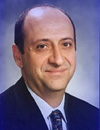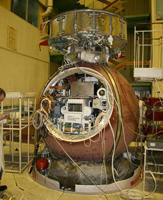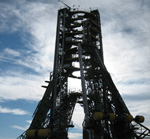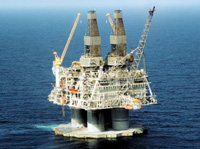|
|
| SCCO Will Make Oil Extraction Easier |
|
|

Foton M3 launch
Low resolution – 1.1 MB
High resolution – 6.8 MB
|
"SCCO was successfully launched on a
Russian Foton recoverable satellite from the
Baikonur Cosmodrome in Kazakhastan on
September 14, 2007, at 7:00 am EDT." |
Slated for launch on September 14, 2007, the Soret Coefficient in Crude Oil experiment (known as SCCO) will make it easier to determine the quantity and quality of crude oil in a given well—without even breaking ground. The experiment is expected to help improve prospecting techniques, as well as the efficiency of oil extraction with related benefits to the Canadian industry (Alberta tar sands and offshore oil). Exploring more efficient methods could also help reduce the environmental impact of oil prospecting.
How oil behaves underground
Usually, gravity causes the heavy components in a fluid to fall and the lighter ones to rise. But thermodiffusion has a strange effect on the distribution of petroleum components in an oil deposit: the heavier ones tend to rise, while lighter ones fall to the bottom of the well.
So the distribution of components in a given well is neither consistent nor predictable. Sampling becomes more complex. How can we be sure from the sample taken that we've found a single well, since the specimens collected are not identical? Could there be two wells?
The Soret effect, minus gravity
Developed by the European Space Agency in co-operation with the Canadian Space Agency, SCCO will examines the influence of temperature gradients on oil wells. A gradient is the difference in temperature between two points beneath the Earth's surface, divided by the distance between them.
Along with a team of students, Dr. Ziad Saghir, researcher and professor at Ryerson University in Toronto, is working on mathematical models to help decipher this unusual phenomenon. Dr. Saghir's research uses thermodiffusion (heat diffusion) to measure the separation that occurs when a mixture of hydrocarbons is submitted to various temperature gradients. This phenomenon is called the Soret effect. |
|

Dr. Ziad Saghir |
To successfully quantify the Soret effect—and produce efficient digital simulators—it helps to eliminate the influence of gravity. In microgravity, the Soret effect will be the main factor in oil dispersion and thus can be observed with precision.

The Foton M3 satellite undergoes testing in Samara, Russia (June 2007). (Photo: C-CORE) |
More efficient extraction
Dr. Saghir and his team are developing digital simulators for the petroleum sector. These will make it easier to determine the quality of oil in a given well and how long the reserves will last. The SCCO experiment will also make it possible to predict the behaviour of various components in an oil well—specifically, how a well is affected by the heaviest components, which push up and displace the gaseous top layer of a well. This top layer of gas is an important indication of the presence of oil. But since it shifts constantly, it's difficult to establish exactly where the well is and how big it is. |
The experiment first flew aboard a 16-day Russian Foton M3 recoverable satellite in 2005. It is scheduled for a second launch on September 14, 2007, from the Russian Baikonur Cosmodrome. After orbiting the Earth for 12 days, it will re-enter the atmosphere, and land in a desert near the border of Russia and Kazhakstan. The experiments will then be retrieved and analyzed, with science results expected about one year afterwards. The CSA is also flying eOSTEO on the same mission (an experiment to study bone loss in space), and is participating in satellite operations. |

Launch Pad for the Soyuz Rocket that will be used to launch Foton M3 into orbit. Nicknamed "Gagarin's Pad," it is the site of Yuri Gagarin's 1961 flight. (Photo: Verhaert Space) |
The CSA is providing the European Space Agency (ESA) with the control software and electronics hardware for SCCO through a contract with C-CORE (St.John's, Newfoundland). The CSA is also supporting the activities of Dr. Saghir, the sole Canadian scientist involved in the SCCO science. |

The electronics control module built by CSA/C-CORE for the Foton M3 SCCO experiment. (Photo: C-CORE) |

The Hibernia drilling platform off the coast of Newfoundland. The oil deposit was discovered in 1979. There are two wells, 2,400 m and 3,700 m deep.
(Photo: Hibernia) |
|
More efficient extraction
Dr. Saghir and his team are developing digital simulators for the petroleum sector. These will make it easier to determine the quality of oil in a given well and how long the reserves will last.
The SCCO experiment will also make it possible to predict the behaviour of various components in an oil well—specifically, how a well is affected by the heaviest components, which push up and displace the gaseous top layer of a well. This top layer of gas is an important indication of the presence of oil. But since it shifts constantly, it's difficult to establish exactly where the well is and how big it is. |
Backgrounder – The Soret Coefficient in Crude Oil Experiment (SCCO)
|
